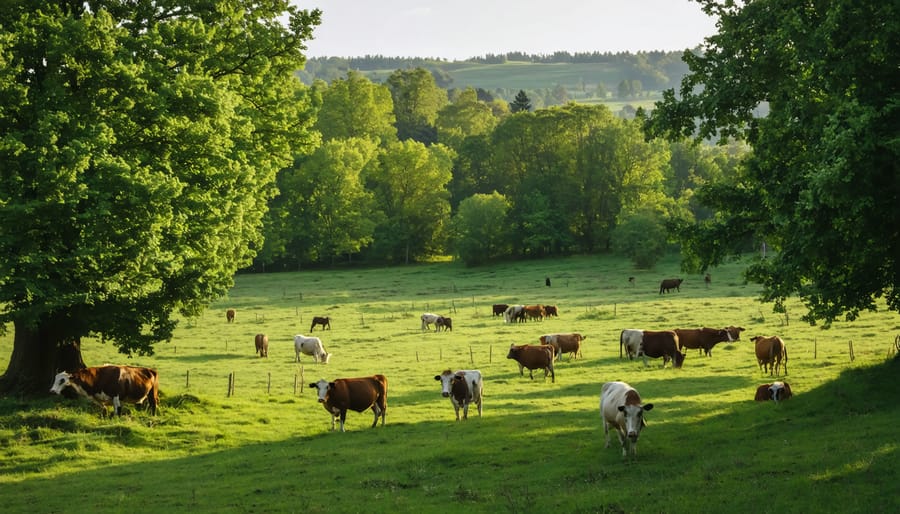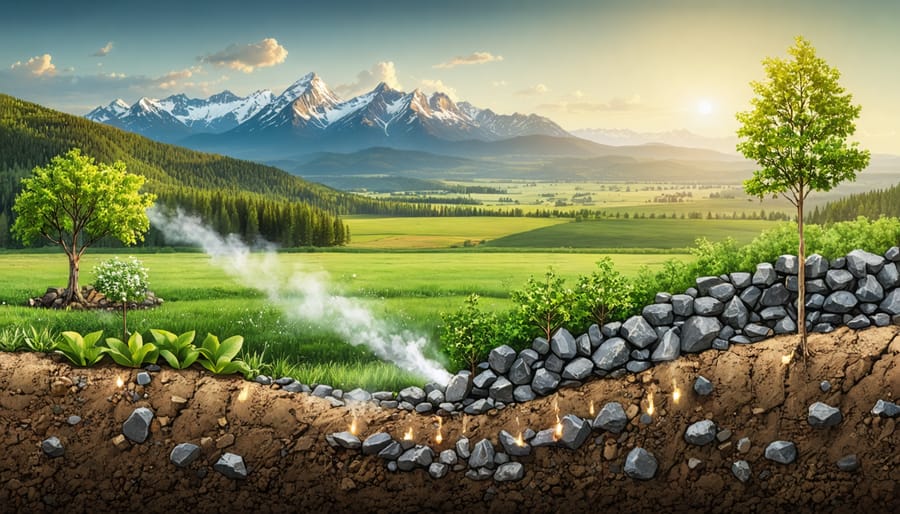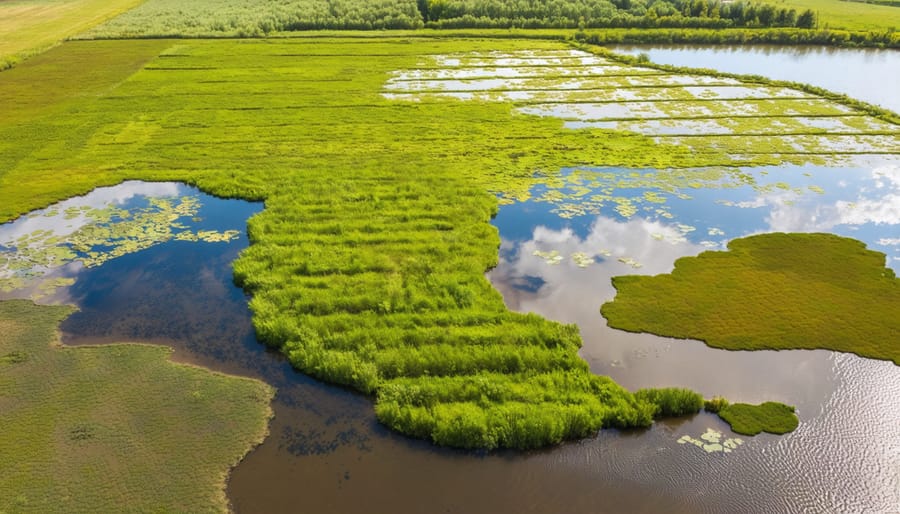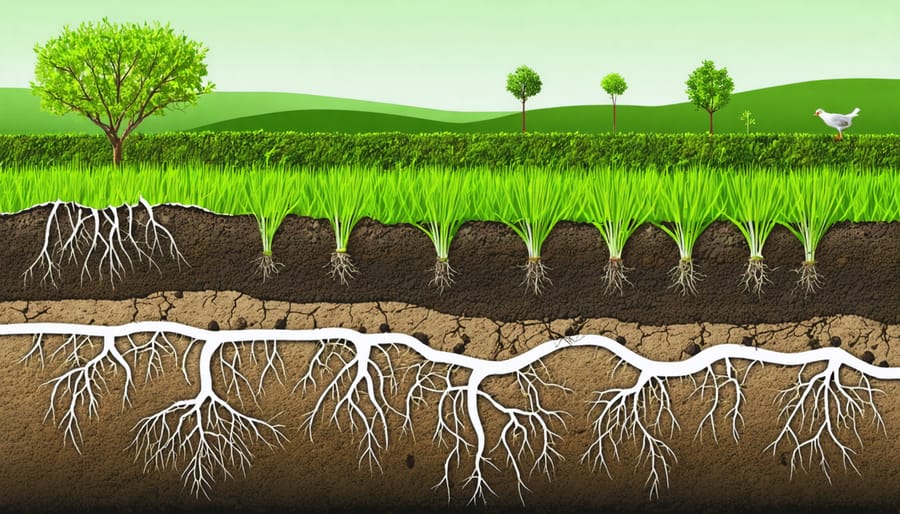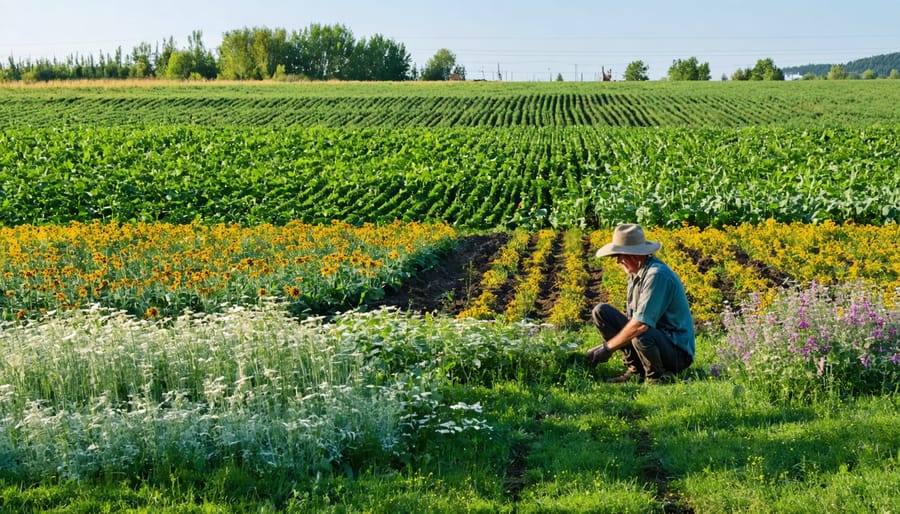Transform your farmland into a powerful carbon sink through proven carbon sequestration in agroforestry systems. Alberta’s agricultural landscape presents unique opportunities to capture and store atmospheric carbon while enhancing soil productivity and farm resilience. By integrating native trees like trembling aspen and white spruce with forage crops, Canadian farmers are already sequestering 2-5 tonnes of carbon per hectare annually. This practical approach combines traditional farming wisdom with cutting-edge carbon management techniques, offering a sustainable solution that benefits both the environment and farm operations.
Recent field trials across central Alberta demonstrate that properly managed silvopasture systems can increase soil organic carbon by up to 25% within five years while maintaining livestock productivity. These results showcase how strategic integration of woody perennials into grazing systems creates multiple income streams while building long-term environmental resilience. For Alberta’s 43,000 farmers seeking practical climate solutions, carbon sequestration techniques offer a tangible path forward that aligns with existing agricultural practices and economic goals.
How Trees Transform Your Pasture into a Carbon Bank
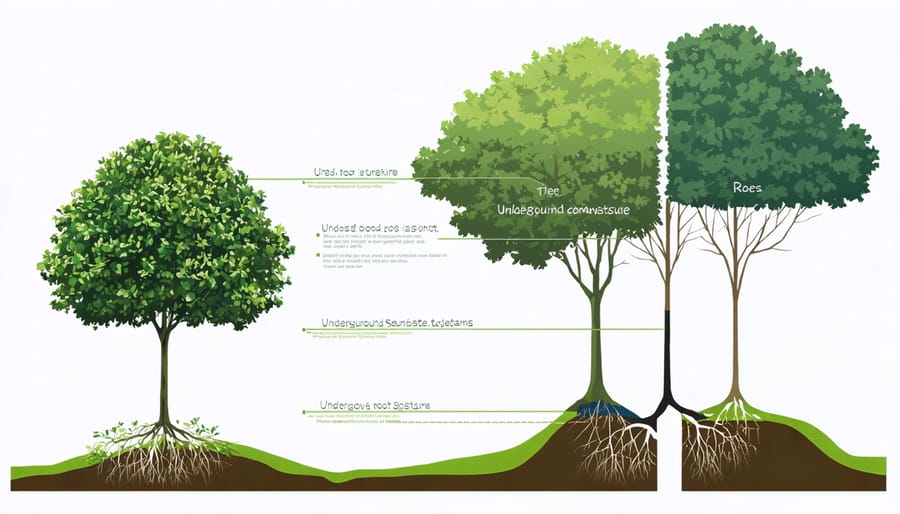
Above-Ground Carbon Storage
When it comes to storing carbon above ground, trees and shrubs are nature’s carbon champions. On Alberta farms, these woody plants convert atmospheric CO2 into solid biomass through photosynthesis, storing it in their trunks, branches, and leaves. A mature poplar, for example, can store up to 200 kg of carbon throughout its lifetime.
The process is straightforward but powerful: as trees grow, they pull carbon dioxide from the air, using it to build their physical structure. About 50% of a tree’s dry weight is pure carbon, making them incredibly efficient carbon storage units. For Alberta farmers, this means every shelterbelt or woodlot on your property is actively working to reduce atmospheric carbon.
Different species store carbon at varying rates. Fast-growing species like hybrid poplars and willows excel at rapid carbon uptake, while slower-growing hardwoods like oak and maple store carbon for longer periods. White spruce, a native Alberta species, provides excellent year-round carbon storage and wildlife habitat.
Local farmer Dave Thompson from Red Deer County shares, “Since establishing our mixed-species shelterbelt ten years ago, we’ve noticed the trees getting bigger each year. It’s satisfying knowing they’re not just protecting our crops from wind – they’re also helping fight climate change.”
Remember, healthy trees store more carbon, so proper maintenance through adequate spacing, regular watering during establishment, and protection from livestock browsing is essential for maximizing carbon storage potential.
Underground Carbon Networks
Beneath the visible landscape of your farm lies a complex network of roots and soil life that plays a crucial role in carbon storage. When we talk about soil organic carbon, we’re referring to a powerful system that can store significant amounts of atmospheric carbon dioxide.
Root systems, particularly those of perennial grasses and trees common in Alberta, create vast underground networks that extend several metres deep. These roots continuously deposit carbon-rich compounds into the soil through a process called rhizodeposition. As roots grow and die, they leave behind organic matter that becomes incorporated into stable soil aggregates.
Here in Alberta, our native prairie grasses are particularly effective at building soil carbon, with root systems that can reach depths of 2-3 metres. Research at the University of Alberta has shown that properly managed grasslands can sequester up to 2.7 tonnes of carbon per hectare annually.
The key to maximizing this underground carbon storage lies in maintaining living root systems year-round. Cover crops, perennial forages, and minimal tillage practices help preserve these networks. Consider implementing rotational grazing, which stimulates root growth while preventing overgrazing. This approach not only increases carbon storage but also improves soil structure, water retention, and overall farm resilience.
Remember, healthy soils support healthy root systems, which in turn build more carbon-rich soil – it’s a beneficial cycle that starts with good management practices.
Proven Tree Species for Alberta Silvopasture

Fast-Growing Carbon Champions
When it comes to maximizing carbon sequestration on your farm, selecting the right species can make all the difference. Among Alberta’s climate-adapted tree species, hybrid poplars stand out as exceptional carbon champions, capable of sequestering up to 5-10 tonnes of carbon per hectare annually during their peak growth years.
White spruce, while slower-growing initially, proves to be a reliable long-term carbon sink, particularly well-suited to our northern climate. These evergreens continue sequestering carbon year-round, even during our cold winters, making them valuable additions to any carbon farming strategy.
For quick results, consider fast-growing shrubs like red-osier dogwood and willow species. These hardy plants not only sequester carbon rapidly but also provide excellent windbreaks and wildlife habitat. Willows, in particular, can be harvested every 3-5 years for biomass while maintaining their carbon-storing root systems.
Looking at understory options, native grasses like blue grama and green needlegrass develop extensive root systems that store significant amounts of carbon below ground. These species are particularly effective when integrated into silvopasture systems, where they complement tree growth while providing grazing opportunities.
Remember that successful carbon sequestration isn’t just about rapid growth – it’s about selecting species that will thrive in your specific soil conditions and microclimate. Consider working with local nurseries and agricultural extension services to identify the best combination of species for your land’s unique characteristics.
Native Species Advantages
Indigenous trees of Alberta have evolved over thousands of years to thrive in our unique climate and soil conditions, making them excellent candidates for carbon sequestration projects. These native species, such as trembling aspen, white spruce, and lodgepole pine, offer several distinct advantages over introduced varieties.
First, native trees are naturally adapted to local weather patterns, requiring less maintenance and irrigation. This resilience translates to higher survival rates and more consistent carbon storage capabilities, even during challenging weather conditions. Our local species have developed robust root systems that efficiently capture and store carbon while improving soil structure.
Local wildlife has co-evolved with these species, creating beneficial relationships that enhance biodiversity and ecosystem health. For example, native birds and insects help with natural pest control and pollination, reducing the need for chemical interventions that could impact carbon sequestration efforts.
From an economic perspective, native species typically cost less to establish and maintain. They’re readily available from local nurseries and often qualify for provincial conservation programs. Many Alberta farmers have reported success with white spruce windbreaks, which not only sequester carbon but also protect crops and reduce soil erosion.
These trees also demonstrate superior disease resistance compared to non-native species, thanks to their natural immunity to local pathogens. This resistance means fewer trees lost to disease and more stable, long-term carbon storage. By choosing native species, farmers can create resilient carbon sinks while supporting local ecosystems and maintaining the natural heritage of our Alberta landscape.
Implementation Strategies That Work
Design and Layout
When planning your carbon sequestration project, proper design and layout are crucial for maximizing carbon capture while maintaining operational efficiency. Start by conducting a detailed site assessment, mapping out your property’s soil types, drainage patterns, and existing vegetation. For Alberta farmers, we recommend dividing your land into management zones based on these characteristics.
Consider your farm’s workflow when placing tree rows or implementing other sequestration features. Spacing between rows should accommodate your largest equipment while maximizing carbon capture potential. A common approach in Alberta is to use 20-metre spacing between tree rows, which allows for comfortable machinery access while maintaining optimal density for carbon sequestration.
Wind direction plays a vital role in layout design. Position windbreaks perpendicular to prevailing winds, typically from the northwest in most Alberta regions. This not only protects soil from erosion but also enhances moisture retention and creates beneficial microclimates for crops and livestock.
For grazing operations, design paddocks that integrate with your tree systems. Consider implementing rotational grazing patterns that allow vegetation adequate recovery time while promoting root growth and soil carbon storage. Many successful Alberta farmers use temporary electric fencing to create flexible grazing cells that can be adjusted seasonally.
Water management should be integrated into your design from the start. Plan for water retention features like swales or small ponds that can support your sequestration efforts while providing additional benefits for your operation.
Establishment Techniques
Begin your carbon sequestration project by conducting a thorough soil test to establish baseline conditions. Local agricultural extension offices can help analyze your soil’s organic matter content, pH levels, and nutrient profile. Once you have these results, develop a site-specific planting plan that considers your land’s topography and existing vegetation.
For tree establishment, start by preparing the soil in early spring or fall. Create planting rows with 3-4 metre spacing between trees and 6-8 metres between rows to accommodate future grazing patterns. When planting seedlings, dig holes twice the width of the root ball and at the same depth. Water thoroughly and apply a layer of organic mulch around each tree, keeping it away from the trunk to prevent rot.
Maintain soil moisture through regular monitoring and irrigation as needed, especially during the first two growing seasons. Install protection measures like tree guards or fencing to prevent damage from livestock and wildlife. Consider incorporating cover crops between tree rows to enhance soil health and provide additional forage.
For optimal results, implement a rotational grazing system once trees are established, typically after 3-4 years. Monitor tree health regularly and conduct annual soil tests to track carbon sequestration progress. Many Alberta farmers have found success by starting with hardy species like white spruce or trembling aspen, gradually expanding their planting areas based on initial results.
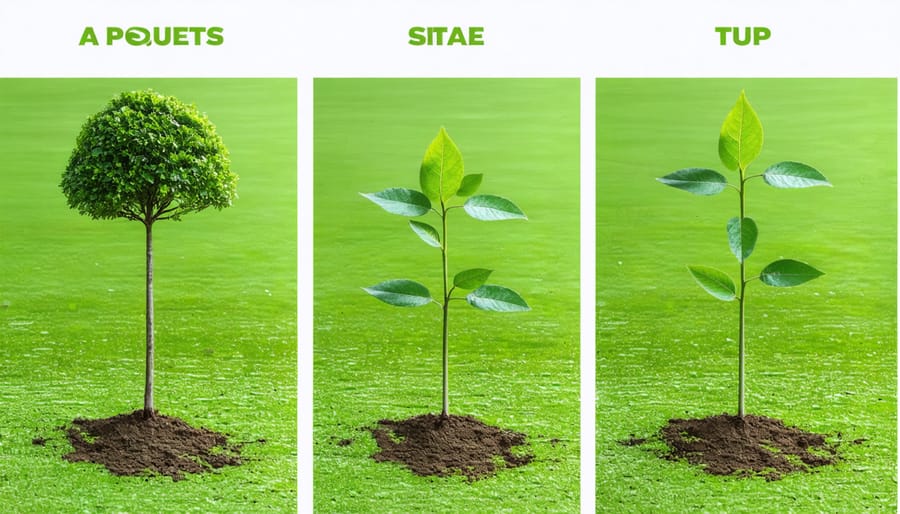
Grazing Management
Effective grazing management is crucial for maximizing carbon sequestration while maintaining healthy livestock and protecting tree investments. Alberta farmers have found success by implementing sustainable grazing management practices that balance these competing needs.
The key is to establish rotational grazing patterns that allow adequate rest periods for both pasture and trees. For optimal results, divide your silvopasture into paddocks of 2-4 hectares, moving livestock every 3-7 days depending on forage availability and season. This prevents soil compaction around trees and allows vegetation to recover between grazing periods.
Young trees require extra protection during their establishment phase. Many Alberta farmers use temporary electric fencing placed 1-1.5 metres from tree rows, moving these barriers outward as trees mature. Others have success with sturdy tree guards for individual specimens, particularly effective for high-value species like hybrid poplars.
Timing is also critical. Spring grazing should begin when grass reaches 15-20 centimetres in height, and animals should be moved before vegetation is grazed below 8 centimetres. This maintains root strength and promotes rapid regrowth. During drought periods, increasing rest periods between rotations helps preserve both forage and tree health.
Local ranchers report that these practices not only protect their tree investments but also improve overall pasture productivity and animal health through better forage management.
Real Results: Alberta Success Stories
Mountain View County Success
In 2019, Mountain View County launched an ambitious carbon sequestration project that has since become a model for agricultural communities across Alberta. Local farmer Sarah Thompson, who manages a 640-hectare mixed farming operation near Olds, partnered with 15 neighbouring farms to implement a comprehensive carbon capture strategy.
The project combined various techniques, including rotational grazing systems and the strategic planting of shelter belts using native species like white spruce and trembling aspen. Over three years, participating farms have documented an average increase of 2.5 tonnes of carbon sequestered per hectare annually, significantly exceeding initial projections.
Key to their success was the establishment of silvopasture systems, where Thompson and her neighbours integrated trees and forage with their existing cattle operations. The project utilized locally-adapted species and implemented careful spacing to optimize both grazing and carbon capture potential. Soil tests conducted by the University of Alberta showed organic matter increases of up to 3% in participating fields.
The economic benefits have been equally impressive. Participants reported a 15% reduction in feed costs through improved pasture management, while several farms qualified for carbon offset credits through Alberta’s emissions trading system. The project also created unexpected benefits, including improved wildlife habitat and reduced soil erosion during spring runoff.
The Mountain View initiative demonstrates how community-based approaches to carbon sequestration can deliver practical results. The county now hosts regular field days where farmers share their experiences and techniques with others interested in implementing similar systems. This knowledge-sharing network has become invaluable for expanding sustainable practices throughout central Alberta.
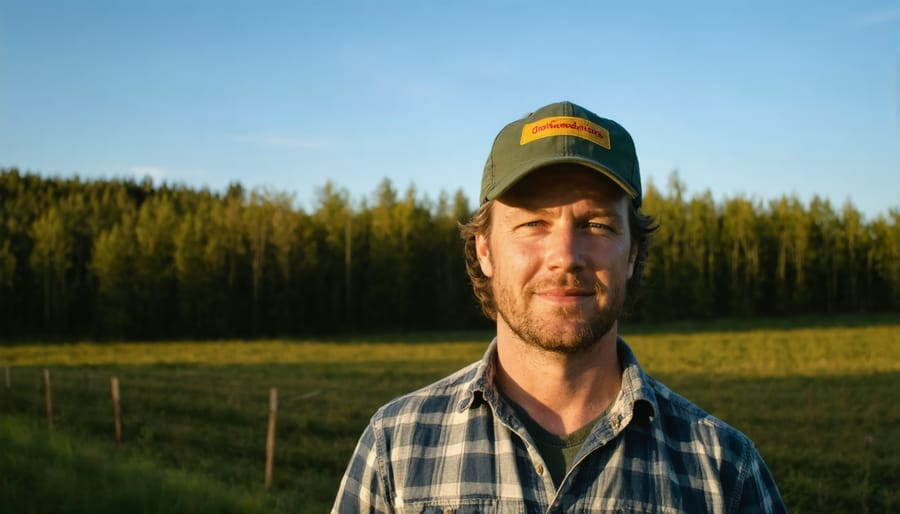
Peace Country Innovation
In Northern Alberta’s Peace Country region, farmers and ranchers are pioneering innovative approaches to carbon sequestration that address unique regional challenges. Local producers have developed adaptive techniques that work effectively in the shorter growing season and specific soil conditions of the area.
The Peace Country Carbon Sequestration Initiative, launched in 2019, has brought together over 200 local producers implementing various carbon capture methods. Notable success has come from combining traditional knowledge with modern techniques, particularly in managing the region’s distinctive grey-wooded soils.
Local farmer Sarah Thompson’s operation near Grande Prairie demonstrates the effectiveness of these adapted practices. By implementing a modified version of rotational grazing suited to northern conditions, her farm has increased soil organic carbon by 2.3% over three years while improving forage productivity.
The Peace Country Agricultural Research Alliance (PCARA) has documented success with winter cover crops specifically selected for the region’s climate. Varieties like fall rye and hairy vetch have shown remarkable resilience, maintaining ground cover through harsh winters and contributing to soil carbon levels even during dormant periods.
Community-led initiatives have been crucial to this success. Monthly farmer-to-farmer workshops in Peace River and surrounding communities facilitate knowledge sharing about what works in local conditions. These gatherings have led to the development of region-specific soil management protocols that account for the area’s unique freeze-thaw cycles and moisture patterns.
The region’s approach demonstrates how local adaptation of broader carbon sequestration principles can yield significant results. Producers have found that understanding and working with regional conditions, rather than against them, leads to more sustainable and effective carbon capture strategies.
As we’ve explored throughout this article, carbon sequestration techniques offer Alberta farmers powerful tools to combat climate change while building more resilient agricultural operations. By implementing these practices, you’re not only contributing to environmental sustainability but also potentially accessing valuable carbon credit opportunities that can boost your farm’s bottom line.
The key to success lies in selecting the right combination of techniques for your specific operation. Whether you choose to focus on cover cropping, reduced tillage, rotational grazing, or agroforestry, remember that every positive change counts. Start small, monitor your results, and adjust your approach based on what works best for your land.
Our Alberta farming community has already demonstrated impressive results, with many producers reporting improved soil health, increased yields, and greater farm resilience within just a few years of implementation. The science is clear: these practices work, and they’re working right here in our province.
Looking ahead, consider taking these next steps:
1. Assess your current farming practices and identify areas where carbon sequestration techniques could be integrated
2. Connect with local agricultural extension services for personalized guidance
3. Join farmer-led discussion groups to share experiences and learn from others
4. Start with a pilot project on a small portion of your land
5. Document your progress through soil testing and careful record-keeping
Remember, you’re not alone in this journey. Our agricultural community is here to support you, and resources are available through local agricultural offices, soil conservation groups, and farmer networks across Alberta. By working together and sharing our experiences, we can build a more sustainable future for Canadian agriculture while maintaining profitable, productive farms for generations to come.
The time to act is now, and every step you take toward better carbon sequestration practices is an investment in your farm’s future.


